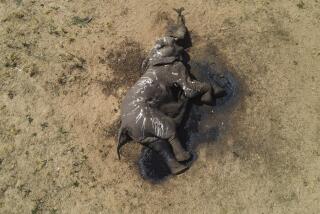Counters Disappointed by Size of Kenya’s Tsavo Elephant Population
- Share via
VOI, Kenya — The pilot nursed the light airplane low over a section of Tsavo National Park while Joseph Gathua squinted to pick out any elephants below.
After 90 minutes in the first elephant count in five years at the 8,400-square-mile park, Gathua saw none--stark evidence of the damage poaching has inflicted on a herd that once numbered 45,000.
As late as 1972, Tsavo had so many elephants that signs on a major highway passing through the park warned motorists that the animals had the right of way.
Widespread poaching led to a ban on hunting in 1977, but enforcement was lax, and by 1988 the herd in Tsavo had dropped to 5,363 elephants.
Local and international outcry forced Kenya’s government to crack down on poaching, and that, together with an international ban on trade in ivory in 1989, helped the herd to increase to 7,317 by 1994.
Paula Kahumbu, a scientist with the Kenya Wildlife Service, said the recently completed elephant count found the herd has increased to 8,100.
But that is below what the experts had expected in view of the 3.8% growth rate charted between 1990 and 1994.
The service’s director, Richard Leakey, had no explanation for the herd’s slowed growth, but he promised to find out why.
“They [elephants] are not taking the pill. The pope has not passed through Tsavo,” he told reporters.
Kahumbu said it had not been determined whether poachers were responsible for five elephant carcasses observed during the count.
Authorities fear the 1997 relaxation on the international sale of ivory will open up a market for poachers, setting off another round of slaughter, especially in Tsavo, home to two-thirds of Kenya’s elephants.
“I believe very strongly, like many other people, that the sale of ivory will lead to poaching,” Leakey said. “We would expect that to be reflected here.”
In June 1997, the 138-nation U.N. Convention on International Trade in Endangered Species approved an easing of the ban to allow Namibia, Zimbabwe and Botswana to sell to Japan 59 tons of elephant ivory stockpiled after the trade ban.
The three countries say selling their ivory stocks would raise money for elephant conservation programs.
After reviewing the nations’ procedures for ensuring illegal ivory does not enter their markets, the convention gave its approval on Feb. 10 for Namibia and Zimbabwe to go ahead with the sale of 33.8 tons of ivory to Japan. Botswana’s procedures are being studied further.
Leakey said if next year’s count in Tsavo points to an increase in poaching, Kenya will fight to make sure no more stockpiled ivory can be sold.
Counting the huge animals--some weigh up to eight tons--isn’t easy.
Kahumbu said the cash-strapped Kenya Wildlife Service first had to raise $45,000 from local and international donors to pay for aviation fuel, vehicles and accommodations. Most of the 55 counters were volunteers, “and we had to turn many others away,” she said.
Every evening, Ian Douglas-Hamilton, head of the private Save the Elephants organization, assigned pilots and their observers to one of the 40 blocks into which the sprawling park was subdivided for the census.
Pilots mapped their routes using a satellite positioning system to provide coordinates to observers who counted the animals and marked their locations.
To give observers adequate time, planes had to fly at 90 miles an hour and hold steady at 400 feet above the ground. Flying low was complicated by gusts of wind caused by the hills that dot the park, the power lines that crisscross it and dozens of communications towers.
At the end of the day, pilots and observers met to make sure there were no double counts of live or dead elephants.
Very large herds were photographed and counted later.
Kahumbu said the observers also counted other significant inhabitants of Tsavo, including buffalo, sable antelope, rhino and Hunter’s hartebeest, or hirola, an antelope-like animal found only in Kenya whose numbers have declined to 400.
More to Read
Sign up for Essential California
The most important California stories and recommendations in your inbox every morning.
You may occasionally receive promotional content from the Los Angeles Times.













